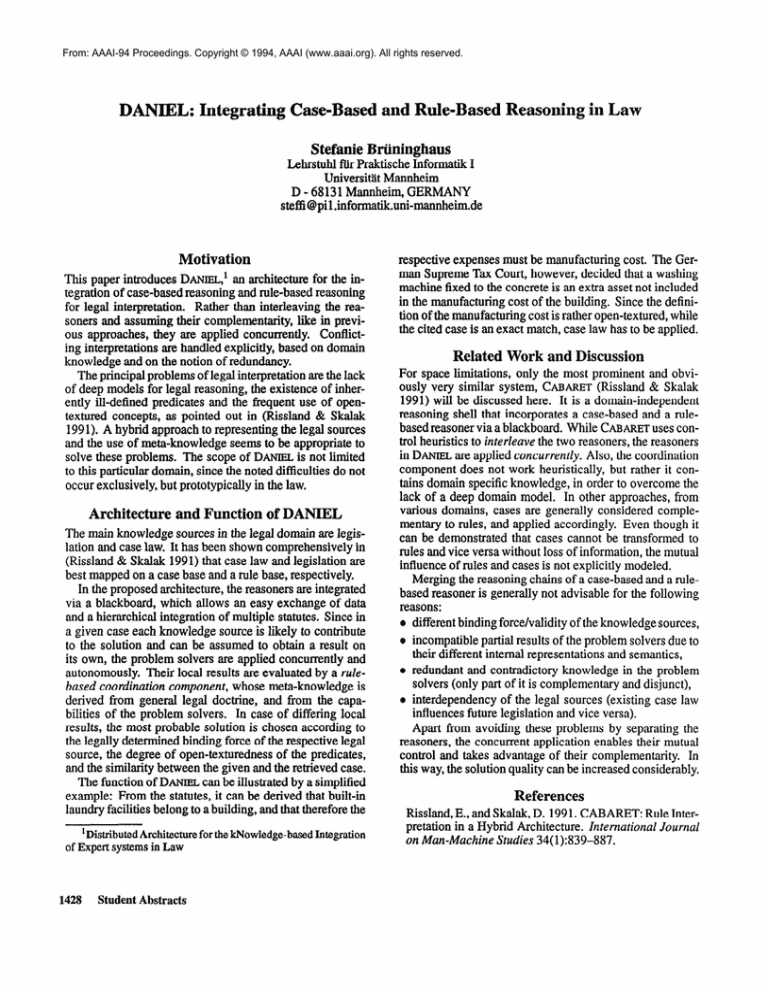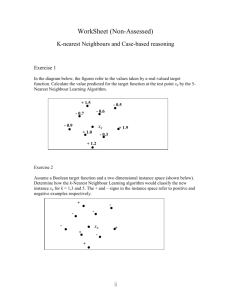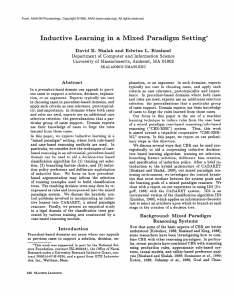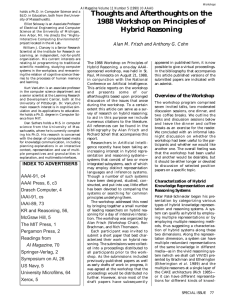
From: AAAI-94 Proceedings. Copyright © 1994, AAAI (www.aaai.org). All rights reserved.
Lr Integrating Case-Based and Rule-Based Reasoning in Law
Stefanie Briininghaus
Lehrstuhl Air F%alctischeInformatik I
Universitit Mannheim
D - 68131 Mannheim, GERMANY
steffi @pi1.informatilc.uni-mannhehnde
Motivation
This paper introduces DANlEL,l an architecture for the integration of case-based reasoning and rule-based reasoning
for legal interpretation. Rather than interleaving the reasoners and assuming their complementarity, like in previous approaches, they are applied concurrently. Conflicting interpretations are handled explicitly, based on domain
knowledge and on the notion of redundancy.
The principal problems of legal interpretation are the lack
of deep models for legal reasoning, the existence of inherently ill-defined predicates and the frequent use of opentextured concepts, as pointed out in (Rissland & Skalak
1991). A hybrid approach to representing the legal sources
and the use of meta-knowledge seems to be appropriate to
solve these problems. The scope of DANIELis not limited
to this particular domain, since the noted difficulties do not
occur exclusively, but prototypically in the law.
Architecture
and Function of DANIEL
The main knowledge sources in the legal domain are legislation and case law. It has been shown comprehensively in
(Rissland & Skalak 1991) that case law and legislation are
best mapped on a case base and a rule base, respectively.
In the proposed architecture, the reasoners are integrated
via a blackboard, which allows an easy exchange of data
and a hierarchical integration of multiple statutes. Since in
a given case each knowledge source is likely to contribute
to the solution and can be assumed to obtain a result on
its own, the problem solvers are applied concurrently and
autonomously. Their local results are evaluated by a rulebased coordination component, whose meta-knowledge is
derived from general legal doctrine, and from the capabilities of the problem solvers. In case of differing local
results, the most probable solution is chosen according to
the legally determined binding force of the respective legal
source, the degree of open-texturedness of the predicates,
and the similarity between the given and the retrieved case.
The function of Dm
can be illustrated by a simplified
example: From the statutes, it can be derived that built-in
laundry facilities belong to a building, and that therefore the
‘Distributed Architecture for the kNowledge-based Integration
of Expert systems in Law
1428
Student Abstracts
respective expenses must be manufacturing cost. The German Supreme Tax Court, however, decided that a washing
machine fixed to the concrete is an extra asset not included
in the manufacturing cost of the building. Since the definition of the manufacturing cost is rather open-textured, while
the cited case is an exact match, case law has to be applied.
Related Work and
For space limitations, only the most prominent and obviously very similar system, CABARET (Rissland & Skalak
1991) will be discussed here. It is a domain-independent
reasoning shell that incorporates a case-based and a rulebased reasoner via a blackboard. While CABARETuses control heuristics to interleave the two reasoners, the reasoners
in DANIEL are applied concurrently. Also, the coordination
component does not work heuristically, but rather it contains domain specific knowledge, in order to overcome the
lack of a deep domain model. In other approaches, from
various domains, cases are generally considered complementary to rules, and applied accordingly. Even though it
can be demonstrated that cases cannot be transformed to
rules and vice versa without loss of information, the mutual
influence of rules and cases is not explicitly modeled.
Merging the reasoning chains of a case-based and a rulebased reasoner is generally not advisable for the following
reasons:
6 different binding force/validity of the knowledge sources,
Q incompatible partial results of the problem solvers due to
their different internal representations and semantics,
a redundant and contradictory knowledge in the problem
solvers (only part of it is complementary and disjunct),
e interdependency of the legal sources (existing case law
influences future legislation and vice versa).
Apart from avoiding these problems by separating the
reasoners, the concurrent application enables their mutual
control and takes advantage of their complementarity. In
this way, the solution quality can be increased considerably.
References
Rissland, E., and Skalak, D. 1991. CABARET: Rule Interpretation in a Hybrid Architecture. International Journal
on Man-Machine Studies 34(1):839-887.







